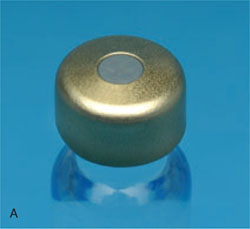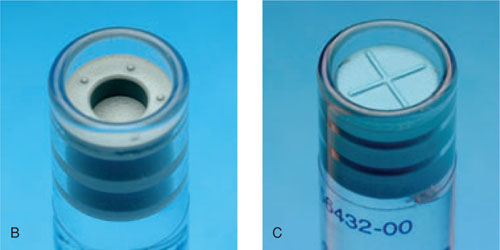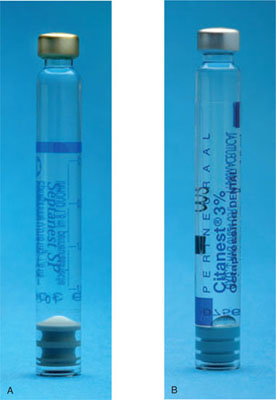4
General practical aspects
In dentistry, local anaesthesia is often required to be able to treat patients. Local anaesthesia facilitates a painless treatment, so that the patient’s comfort is maximal during the treatment and so that the dentist is able to work calmly, with concentration and precision. This benefits the end result and the way this is achieved. Local anaesthesia is also used for diagnostic purposes to identify the cause of pain in the face, using selective anaesthesia. It is also used to prevent short- or long-term postoperative pain.
4.1 Use of local anaesthetics
Local anaesthesia may be applied preventatively when the dentist expects that dental treatment will be uncomfortable or painful and/or if the patient cannot bear pain very well. In other cases the anaesthetic is only used once pain does actually occur and/or if the patient indicates that he/she is no longer able to bear the pain.
Depending on the experience of the dentist and his/her knowledge of the patient’s character, there is usually a preference for using preventative anaesthesia. This helps to increase the patient’s confidence in the dentist and the treatment (‘rather proactive than reactive’). Of course it makes a difference whether local anaesthesia is used for sub- or supragingival cleaning, for a cavity preparation, a crown or operative extraction of a wisdom tooth, or an extensive periodontal ‘flap’ procedure. There is also a difference in the way local anaesthetics are used for adults and children (see Chapter 8). Table 4.1 provides some general guidelines for the use of various techniques and indications for local anaesthesia.
4.2 Indications and contraindications
Before administration of an anaesthetic, the dentist must first explain why it is necessary. Indications and contraindications only have reference to the individual patient. Therefore, careful consideration must be made in the case of each patient, whether or not it is possible or suitable to use anaesthesia. This involves obtaining a good medical history and making enquiries related to previous experiences with local anaesthesia. The medical history should be well structured, systematic and preferably in written form. Negative findings such as ‘no medication’, ‘no allergies’ and ‘no bleeding tendency’ must also be documented. When enquiring about earlier experiences, it is important to continue asking for details, e.g. what the patient means by ‘collapse’ or ‘allergy to adrenaline’. Some physical reactions may be based on a nervous, mostly involuntary response. Examples of this are dizziness, nausea, stomach pains, fainting and sweating. Other symptoms, however, may indicate an overdose, allergic reactions or interaction with the prescribed medication that the patient is already taking. Table 11.1 gives recommendations for the use of local anaesthetics in medically compromised patients.
Table 4.1 General guidelines and indications for the use of various techniques to administer local anaesthesia.
Abbreviations:
HTA = high tuberosity anaesthesia (block anaesthesia)
IL = intraligamental anaesthesia
INA = infraorbital nerve anaesthesia
INF = infiltration anaesthesia
MB = mandibular block (block anaesthesia)
MNB = mental nerve block
NNP = nasopalatine nerve anaesthesia
PN = (greater) palatine nerve block
| Therapeutic/diagnostic | Lower jaw | Upper jaw |
| Cleaning | ||
| Limited | INF | INF |
| Extensive | MB | INF |
| Filling/crown | MB + INF | INF |
| Endodontics | MB (IL) | INF |
| Extraction | MB + INF | INF |
| Periodontal surgery | MB + INF | HTA, INA, PN |
| M3 inferior/superior extraction | MB + INF | NNP |
| Implantation | MB + INF | HTA + PN |
| Pre-implantological surgery | MB + MNB | HTA + PN |
| Central or peripheral pain? | MB | HTA + PN + INF |
| Dentogenic or non-dentogenic? | MB | INA, HTA |
| Which tooth? | IL | IL or INF |
After explaining the nature of the anaesthesia, the dentist must verify whether the patient has understood this explanation. The patient may have additional questions that have to be answered first. Eventually the dentist will ask, more or less explicitly, for permission to anaesthetise (informed consent). If a patient does not protest against the use of a local anaesthetic, this does not mean that he/she is giving implicit permission (see Chapter 12).
4.3 Instruments
For the application of local anaesthetics in dentistry, almost exclusively use is made of glass cartridges with anaesthetic fluid, disposable needles and an aspirating syringe.
4.3.1 Cartridges
The glass cartridges usually contain 1.7–1.8 ml of anaesthetic fluid, although in the UK also 2.2 ml cartridges are available. In this textbook, recommendations are based on cartridges of 1.8 ml. The cartridge is closed, on one side by a rubber or synthetic diaphragm and on the other side by a rubber or synthetic stopper that may or may not be prepared for aspiration (Figure 4.1). The outside of the cartridge is printed with the name, composition and vasoconstrictor of the local anaesthetic. This information is printed on the glass or on a thin plastic foil. The latter ensures that, if the glass breaks (with intraligamental anaesthesia), the fragments are held together by the plastic foil and do not end up in the oral cavity (Figure 4.2).
Figure 4.1 A Top of an anaesthetic cartridge with diaphragm, into which the needle can be pierced.

Figure 4.1 B and C Bottom of an anaesthetic cartridge with stopper that is (B) or is not (C) prepared for aspiration.

Figure 4.2 A and B Glass anaesthetic cartridges with plastic foil on which the composition of the content is noted; articaine 4% with epinephrine 1:100,000 (A) and prilocaine 3% with octapressin (B).

Cartridges are delivered in sterile packing and on the cartridges the expiry date, the stock number and other information are written (Figure 4.3). A cartridge that has just been unpacked does not need to be disinfected before use with, for example, chlorhexidine in alcohol. It is also not advisable, for various reasons, to preserve cartridges in disinfectant fluid.
Figure 4.3 Cartridges are delivered in a sterile packing, and are printed/>
Stay updated, free dental videos. Join our Telegram channel

VIDEdental - Online dental courses


